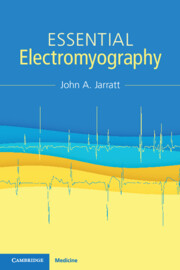Book contents
- Essential Electromyography
- Essential Electromyography
- Copyright page
- Dedication
- Contents
- Figures
- Diagrams
- Tables
- Preface
- Acknowledgements
- Abbreviations
- Chapter 1 Introduction
- Chapter 2 Basic Anatomy and a Little Physiology
- Chapter 3 Peripheral Nerve Types
- Chapter 4 Peripheral Nerve Function
- Chapter 5 The Neuromuscular Junction
- Chapter 6 Muscle
- Chapter 7 Some Technical Matters: Electrodes, Stimulators, Amplifiers, Display, Averagers
- Chapter 8 Volume Conduction
- Chapter 9 Pathology
- Chapter 10 Electromyography (EMG)
- Chapter 11 Nerve Conduction Studies (NCS): Introduction
- Chapter 12 Nerve Conduction Studies: Normal
- Chapter 13 Nerve Conduction Studies: Degeneration
- Chapter 14 Nerve Conduction Studies: Demyelination
- Chapter 15 Degree of Pathology
- Chapter 16 Tests of Neuromuscular Transmission
- Chapter 17 Other Techniques: F-waves and H-reflexes
- Chapter 18 Clinical Applications
- Chapter 19 Other Stuff: Aberrant Nerve Pathways, A-waves, EMG Anomalies
- Chapter 20 Normal Values
- Chapter 21 Conclusion
- Glossary
- Further Reading
- Index
Chapter 8 - Volume Conduction
Published online by Cambridge University Press: 14 September 2023
- Essential Electromyography
- Essential Electromyography
- Copyright page
- Dedication
- Contents
- Figures
- Diagrams
- Tables
- Preface
- Acknowledgements
- Abbreviations
- Chapter 1 Introduction
- Chapter 2 Basic Anatomy and a Little Physiology
- Chapter 3 Peripheral Nerve Types
- Chapter 4 Peripheral Nerve Function
- Chapter 5 The Neuromuscular Junction
- Chapter 6 Muscle
- Chapter 7 Some Technical Matters: Electrodes, Stimulators, Amplifiers, Display, Averagers
- Chapter 8 Volume Conduction
- Chapter 9 Pathology
- Chapter 10 Electromyography (EMG)
- Chapter 11 Nerve Conduction Studies (NCS): Introduction
- Chapter 12 Nerve Conduction Studies: Normal
- Chapter 13 Nerve Conduction Studies: Degeneration
- Chapter 14 Nerve Conduction Studies: Demyelination
- Chapter 15 Degree of Pathology
- Chapter 16 Tests of Neuromuscular Transmission
- Chapter 17 Other Techniques: F-waves and H-reflexes
- Chapter 18 Clinical Applications
- Chapter 19 Other Stuff: Aberrant Nerve Pathways, A-waves, EMG Anomalies
- Chapter 20 Normal Values
- Chapter 21 Conclusion
- Glossary
- Further Reading
- Index
Summary
Potentials are recorded in the clinic using extracellular electrodes. These are near-field potentials as opposed to the far-field potentials recorded during studies of evoked potentials. Signals which approach, pass beneath an extracellular electrode and then continue onwards register a triphasic potential. Signals which do not pass beyond the electrode are characterised by a diphasic potential in which the initial positive wave is followed by a slow return to the baseline. Potentials which arise immediately beneath the recording electrode are diphasic, the initial phase being negative. These properties can be exploited to increase the size of recorded nerve action potentials.
- Type
- Chapter
- Information
- Essential Electromyography , pp. 24 - 26Publisher: Cambridge University PressPrint publication year: 2023

